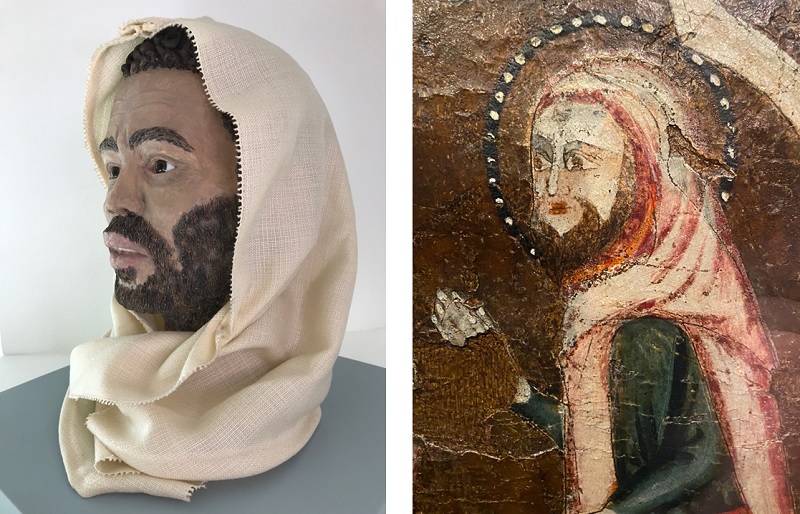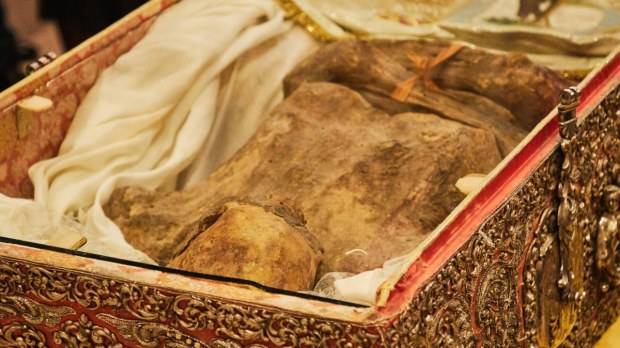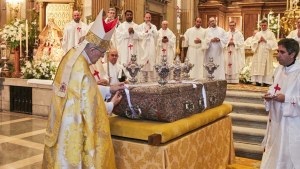The recently released results of a forensic study on the remains of St. Isidore the Farmer confirm what the canonization bull says about his death – namely, that he died between the ages of 35 and 45.
Isidore the Farmer lived between the 11th and 12th centuries. Born in Madrid around the year 1070 to a poor and devout family, he was baptized with the name Isidore, after the 6th-century saint and scholar Isidore of Seville, often referred to as “the last scholar of the ancient world.”
A farmworker in the service of the wealthy landowner Juan de Vargas, he is the patron saint of farmers and of Spain’s capital city, Madrid. As this year marks the 400th anniversary of his canonization, Pope Francis granted a jubilee year to the diocese of Madrid, the Holy Year of San Isidro.
When presenting the results of the forensic study, the Archbishop of Madrid, Cardinal Carlos Osorio, explained that “the decision to carry out this study shows that the Church is not afraid of anything and that, leaning on scientific advances, we can learn more about men like St. Isidore, an example of sanctity for his contemporaries and for millions of believers around the world throughout the centuries.”

The study also notes that, since the saint was first buried in San Andrés, in a rather watery and humid area, there are “different levels of density in the back part of some bones.” It also explains that his body presents “characteristics typical of Afro-descendant groups” and that a coin was found in the back of his throat.
Cardinal Osorio said that the results of the study reaffirm what tradition has always claimed regarding St. Isidore. He also added that, by revealing his Afro-descendant origins, the study evidences “the hospitality that Madrid has always offered to the whole world, and thus that which St. Isidore himself gave to others.”
A coin in his throat, and the cause of his death.
The study noted “a metallic object in the shape of a coin that, given its location, could not be observed directly.” The team in charge of it believe this coin may bear the inscription of the silhouette of a lion rampant, framed in a rhombus.
A numismatic study of the object explains that, despite the absence of more detailed images, it could be a ‘Blanca del Rombo’ coin of Enrique IV, a 15th-century king of Castile and León. The researchers admit that the coin remains “an unsolved mystery,” even though it is known that King Enrique visited the tomb of the saint in 1463.
The researchers were also unable to determine the cause of his death, although there are some indications that it was due to sepsis. “There is evidence of signs of disease and infections in the maxillary bones, with significant abscesses and fistulas, which may be a consequence of clinical symptoms of mediastinitis, which sometimes leads to sepsis,” the report says.
The study explains that its conclusions “do not contradict any of the elements that reliable traditions have attributed to the life and history of St. Isidore. This, and the uninterrupted chain of custody of his remains since his exhumation 40 years after his death, makes it highly probable that we are in the presence of the body of the saintly 12th-century farmer from Madrid.”
The Collegiate Church of St. Isidore
The church of San Isidro El Real was designed by the famed Baroque architect Pedro Sánchez in 1620. He oversaw its construction until his death in 1633. The work was finished in 1664 by Francisco Bautista and Melchor de Bueras.
The church was built to replace the parish church of St. Peter and St. Paul, which had been demolished to make room for the Imperial College, as commanded by the Holy Roman Empress Maria of Austria, daughter of Charles I and sister to King Philip II of Spain: In her will, she left her fortune to the Jesuits so that they could finish the building.
The church was consecrated on September 23, 1651 — 13 years before its completion. Since it belonged to the Jesuits, the church was dedicated to to St. Francis Xavier. But when the Jesuits were expelled in 1767, the building became a collegiate church. Two years after that, with the arrival of St. Isidore’s remains, the church changed its name to San Isidro El Real.
Saint Isidore “Labrador”
Isidro de Merlo y Quintana (the full Spanish name of St. Isidore) is often referred to in English as “St. Isidore the Laborer.” But that translation is somewhat inaccurate or, at least, insufficient. In Spanish, he is known as “San Isidro Labrador.” The Spanish word “labrador” derives from the verb labrar, meaning “to plow.” In a broad yet also very specific sense, labrar means “to work the land.” The English “laborer” does not include the farming overtones found in the Spanish labrador, which are essential to his identity as patron saint of farmers.



